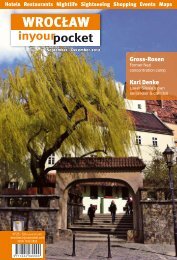Create successful ePaper yourself
Turn your PDF publications into a flip-book with our unique Google optimized e-Paper software.
36 What to see<br />
premises of the Museum of the City and numerous art<br />
ateliers, galleries, and artisan workshops. The terrace of<br />
the fortress, by the Clock Tower, boasts splendid views<br />
of the town.<br />
The clock on the Tower is unique in that the big hand tells<br />
hours and the small one minutes. This was allegedly done<br />
so that the boatmen travelling on the Danube could see<br />
the time from a long distance. The clock is slow when it<br />
is cold and fast when it is hot, so people have dubbed it a<br />
‘drunken clock’. The fortress features several restaurants<br />
and night clubs and it is famous for EXIT - the best music<br />
festival in Europe 2007. Were it not for the scarcity of<br />
garbage bins and rather random park cleaning service, it<br />
would have been perfect.<br />
You may get to the top plateau of the fortress by car,<br />
just follow the signs for Leopold Hotel. If on your way up<br />
you should see a lonely vehicle and some commotion<br />
inside, don’t worry, with the crime rate so small as in Novi<br />
Sad, that must be an amorous couple, but give it a wide<br />
berth anyway. The long arched passage is too narrow<br />
for two-way traffic, so do follow the instructions by the<br />
officers placed at its ends, who communicate the arrival<br />
of vehicles to one another over the radio set. You can get<br />
to the fortress by bus Nº3, taxi, or take a leisurely walk,<br />
because it is not too far.<br />
The bridges The first temporary pontoon bridge was<br />
erected in 16 century by Turkish army, before that inhabitants<br />
and soldiers had used ferry boat to cross the river Danube.<br />
First permanent, iron bridge named Franz Joseph, designed<br />
by Karl Baumann, was built in 1883. The remains of this<br />
bridge can still be seen.<br />
Novi Sad bridges were demolished and rebuilt couple of<br />
times during city’s history. There are three bridges that<br />
connect the Danube banks today: Varadin bridge, Raillway<br />
and Liberty bridge.<br />
Jewish Novi Sad<br />
Novi Sad’s beach on the Danube is the place to be during the warmer months of the year<br />
Jewish community Novi Sad B-2, Jevrejska 11,<br />
tel. 42 38 82. The Jewish community of Novi Sad was<br />
allowed to build its first synagogue in the early 18th<br />
century. The local Jewish community belonged culturally<br />
to the Hungarian Jewry. Only about a quarter of the more<br />
than 4,000 Jews of Novi Sad survived the Holocaust<br />
that followed the German invasion of Yugoslavia in<br />
1941 and the annexation of Novi Sad to Hungary. Over<br />
800 Jews of Novi Sad - men, women and children of all<br />
ages - were murdered during massacres conducted by<br />
the Hungarian police against Jews and Serbs in January<br />
1942. <strong>In</strong> May 1944, the synagogue of Novi Sad served as<br />
an arrest house for the Jews of Novi Sad and it was from<br />
there that they were deported to the Nazi extermination<br />
camps. The synagogue was consecrated again in 1945<br />
when it became the focal point of the revived Jewish life<br />
in the city. The Jewish population of Novi Sad dwindled<br />
further as many members of the local community chose<br />
to immigrate to Israel and other countries in the 1950’s.<br />
There were an estimated 400 Jews in Novi Sad in the<br />
early years of the 21st century.<br />
Synagogue B-2, Jevrejska 11. One of Novi Sad<br />
landmarks This impressive building in the style of<br />
Hungarian secession was completed in 1909. As the<br />
Jewish community no longer could support the costs<br />
of maintenance, in 1991 it was leased to the city for<br />
a period of twenty five years. Taking advantage of the<br />
fine acoustics of the synagogue building, the city, having<br />
restored the interior, decided to use it as a concert hall for<br />
classic and other music events. The Jewish community,<br />
nevertheless, is able use the synagogue whenever it<br />
wishes, as they do each year, for celebrating major<br />
Jewish holidays.<br />
Novi Sad <strong>In</strong> <strong>Your</strong> <strong>Pocket</strong> novi_sad.inyourpocket.com

















